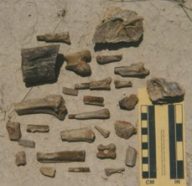Fingerprinting fossils
Researchers can find out in what kind of soil a fossil was originally buried.
By Emily Sohn
A bone is a bone is a bone. Or so it seems.
To an untrained eye, a fossilized bone doesn’t tell much of a story. Scientists, on the other hand, can date a fossil with amazing precision. They can also tell a lot of things about how the animal lived and died. Now, they can even learn about the place where the fossil originally formed.
 |
|
Many different kinds of fossils can be found in Badlands National Park in South Dakota.
|
| Dennis O. Terry, Temple University |
Geologists from Temple University in Philadelphia have found a way to determine the kind of soil that fossils came from, even when the fossils are millions of years old and far from their original locations. Their method relies on detecting atoms of certain elements known as rare earths.
The bodies of living animals contain tiny amounts of rare-earth elements. When an animal dies and is buried in mud or dirt, its bones gradually pick up additional amounts of rare earths from the soil. The process takes up to 30,000 years, at which point the fossil holds a permanent record of the soil’s composition at the time. The rare earths serve as a sort of fingerprint.
Different soils may contain different concentrations of various rare-earth elements. By comparing a fossil’s rare-earth composition with that of different soils, it’s possible to pinpoint the type of soil and possibly where the fossil came from.
Scientists hope that the new method will help them piece together the ecology of ancient times. For example, the Temple researchers were able to figure out whether certain animals, whose fossils were from different parts of Badlands National Park in South Dakota, were buried in ancient flood plains or in stagnant lakes.
If soil signatures differ from one place to another, the technique might also help law enforcement officials nab people who illegally steal fossils from protected lands. Fossil poaching is a big problem in the Badlands, and park rangers would be able to tell if a seized fossil actually came from the park.
 |
|
This set of fossils was taken away from people who illegally gathered the bone fragments at Badlands National Park.
|
| Dennis O. Terry, Temple University |
Every bone has a story to tell. We’re now one step closer to understanding what they have to say.







